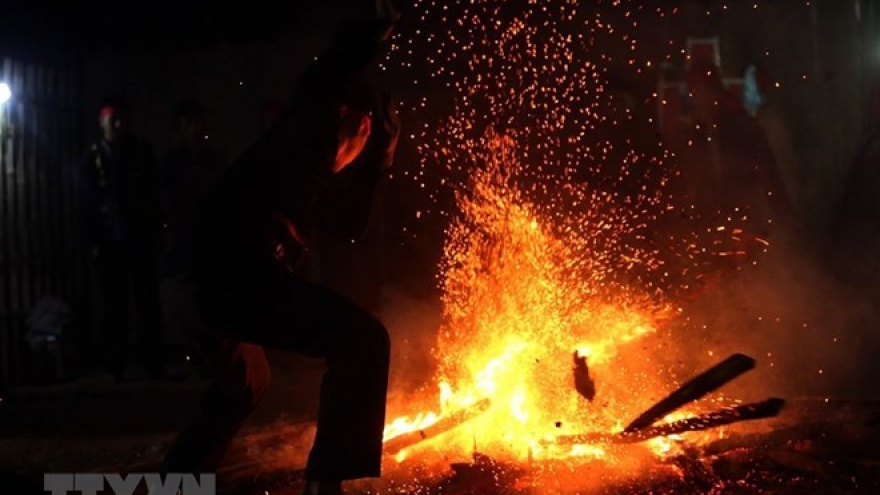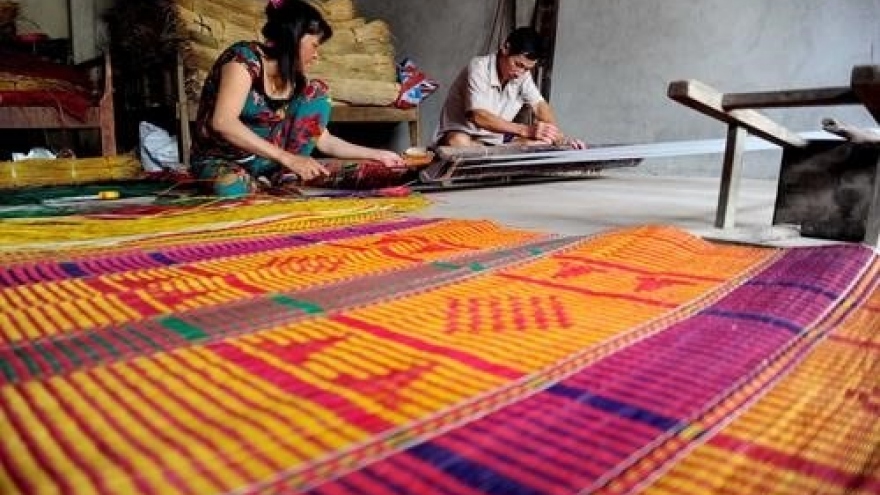Ha Nhi ethnic group's earthen-wall houses and traditional New Year celebration
VOV.VN - Ha Nhi ethnic people’s earthen-wall houses are warm in the winter and cool in the summer. Their unique houses help them deal with the harsh weather of the northern mountain Vietnam.
 |
| Members of a Ha Nhi family are making glutinous rice cake to prepare for New Year's Eve (Photo: Nhat Minh) |
After choosing an auspicious day to begin, the prospective home owner sprinkles 3 seeds on the ground to symbolize growth, development, and a good harvest. The stage from excavating the footing to erecting the earthen walls is very complicated.
The house’s rock foundation is about 1m high to avoid ground moisture. Ha Nhi people select clay soil with high adhesion, pack it into a 40-inch wide mould, and compress it tightly between sheets of plywood. They use the wooden tools to make the inside and outside wall surfaces smooth. Finally, they add the house’s beams and roof.
70-year-old Chu Po Chu of Thu Lum commune, Lai Chau province, said “It takes a long time, normally a month, to build an earthen-wall house, because it is a complicated process. All of the work is done by the people in the village. It’s a tradition in our commune to help each other build earthen-wall houses. We only give the builders food and drinks. We don’t pay them money”.
The beauty of earthen-wall houses is in their architecture. The houses have 4 roofs, 3 rooms, a large porch on the front, several doors, and no windows. On the right and left of the house are 2 bedrooms. The middle room is for family gatherings. A corridor might contain a bed for guests or any unmarried man in the family. Cooking smoke adheres to the walls and makes the house more durable over time.
Unlike the custom of many other ethnic groups, there is no altar or incense burner in a Ha Nhi house, but there is a sacred place of worship.
Mr. Chu Xe Lu told VOV “Ha Nhi grandparents and parents live on the east side, and their daughters-in-law, daughters, and grandchildren live on the west side. In the place of worship, we choose chestnuts that are not rotten, put them on a rug, and hang it up in the main room facing the sunrise. The offering is a bowl of meat, a little rice, and some wine. Ha Nhi people do not burn incense.”
When a new house is completed, the family invites their relatives and neighbors to a house warming ceremony. Each house is a project for the whole village. 60-year-old Xu Xa Nu said “I like living in my earthen-wall house. It is part of our village’s traditions. I want to preserve this tradition for my children”.
The lives of the Ha Nhi have been improving. Many families now have a tile roof instead of a thatched roof on their earthen-wall house. Their houses are now more durable but still have the unique beauty of the traditional Ha Nhi earthen-wall house.
The Ha Nhi ethnic people of Lai Chau province schedule their New Year (Tet) celebration based on the weather, the harvest season, and each family’s economic situation. It’s normally in November of the solar calendar, when Ha Nhi farmers complete their work and are ready to welcome a new year.
“Ko Nhe Tra”, the New Year celebration of the Ha Nhi, lasts 3 days. These days are chosen by each village and commune. Ha Nhi people have a tradition of fetching water in the early morning of the first day of the New Year celebration. They believe that fetching water at the beginning of the year brings good luck for the year and gives them fresh water for cooking during Tet.
A Ha Nhi New Year celebration is well prepared. They wear their traditional costumes, make a lot of floating cakes, round and square glutinous rice cakes as offerings and presents for their children and guests.
The worship of the Ha Nhi people is very simple with no incense or votive candles. Offerings for their ancestors are made by the children: round glutinous rice cake, driftwood, wine, ginger, chili salts, rice, and meat. The worship ceremony is performed by the women. The place of worship is above the bed head of the house owner or in the corner of the kitchen.
Mr. Chu Po Chu said "Ancestor worshiping is mainly done by the women, who are also the ones who take care of the housework. The ceremony is very simple. Offerings are whatever is available in the house, normally pork, chicken, rice, and wine.”
“Ko Nhe Tra”, the New Year celebration of the Ha Nhi people, is a joyous occasion. The elderly visit other families and wish them the best of luck. On New Year's Eve, the most honored guests are invited to a private meal. The community singing and dancing area attracts local boys and girls eager to participate in folk games.
The third day marks the end of the Lunar New Year celebration. A ritual pays respect to Heaven and Earth and prays for good health, a bumper crop, and a lucky and peaceful new year.
Chu Xe Lu, Secretary of Thu Lum commune’s Party Committee, said "There are two ceremonies: the first is a review of the old year and the second is the official worship with chickens as offerings. Three days after the Lunar New Year celebration, we prepare a special meal to thank Heaven and Earth. The blessing of Heaven and Earth is important to us. The praying ceremony takes place on the 4th day of the New Year”.


